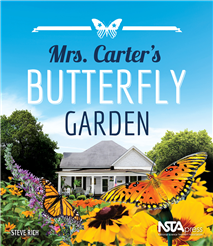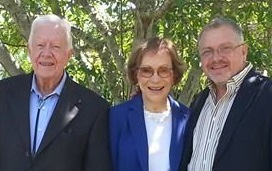Why Did Mrs. Carter Ask a Science Teacher to Create a Butterfly Garden?
By Guest Blogger
Posted on 2014-10-30
 It’s not every day that a science-teacher-turned-author gets the call that a former first lady of the United States could use his help. When that happened to me, I was uncertain if I would have anything to offer someone of Mrs. Carter’s stature. I dusted off my decades-old copy of her autobiography for a refresher on Mrs. Carter’s incredible life and assured myself that if she wanted a garden to attract monarch butterflies, I had the experience she needed—my 15 years of middle and elementary school teaching would come in handy in the months to come! Within 48 hours, I had security clearance and found myself in Mrs. Carter’s front yard helping her and the National Park Service plan a butterfly garden that would one day be part of the gardens surrounding a presidential burial site.
It’s not every day that a science-teacher-turned-author gets the call that a former first lady of the United States could use his help. When that happened to me, I was uncertain if I would have anything to offer someone of Mrs. Carter’s stature. I dusted off my decades-old copy of her autobiography for a refresher on Mrs. Carter’s incredible life and assured myself that if she wanted a garden to attract monarch butterflies, I had the experience she needed—my 15 years of middle and elementary school teaching would come in handy in the months to come! Within 48 hours, I had security clearance and found myself in Mrs. Carter’s front yard helping her and the National Park Service plan a butterfly garden that would one day be part of the gardens surrounding a presidential burial site.
 The diminutive Mrs. Rosalynn (as she is affectionately known) exudes a certain soft-spoken elegance in addition to her ability to make everyone in her presence feel comfortable and welcomed. She listened intently to my butterfly-gardening suggestions, asked good questions, and had firm ideas that a garden should have a purpose that serves its surrounding environment. In this case, bringing butterflies and other pollinators to her hometown of 700 people would be helpful to the farmers in the area whose crops could benefit. Furthermore, schoolchildren and other visitors could learn from the garden when it eventually opened to the public. When she found out that multiple gardens would promote a higher butterfly population, she wanted to make that happen.
The diminutive Mrs. Rosalynn (as she is affectionately known) exudes a certain soft-spoken elegance in addition to her ability to make everyone in her presence feel comfortable and welcomed. She listened intently to my butterfly-gardening suggestions, asked good questions, and had firm ideas that a garden should have a purpose that serves its surrounding environment. In this case, bringing butterflies and other pollinators to her hometown of 700 people would be helpful to the farmers in the area whose crops could benefit. Furthermore, schoolchildren and other visitors could learn from the garden when it eventually opened to the public. When she found out that multiple gardens would promote a higher butterfly population, she wanted to make that happen.
 Though it was her meeting, Mrs. Carter graciously allowed her husband to give input. Even though Jimmy Carter was the 39th president of the United States, it’s clear that he respects his wife’s projects and values her work and their partnership, which has lasted 68 years. Typical of the keenness of both Carters, the former president asked if any of the plants I suggested would bring unwanted pests to their yard. I explained that aphids would likely follow the milkweed to the yard, but that pesticides are not an option in a butterfly garden. This piqued the interest of both President and Mrs. Carter. When I suggested that ladybugs would be an environmentally friendly, natural option, the Carters looked at each other, seemingly sharing the same thought. The Carters’ local church has a couple of ladybug infestations a year, and they could bring some ladybugs home when it was their turn to help clean the building. (Yes, the former first couple helps clean their church!) As I reflected on the conversation, I often imagined the shoe box full of ladybugs they might bring home from their church to release in their garden.
Though it was her meeting, Mrs. Carter graciously allowed her husband to give input. Even though Jimmy Carter was the 39th president of the United States, it’s clear that he respects his wife’s projects and values her work and their partnership, which has lasted 68 years. Typical of the keenness of both Carters, the former president asked if any of the plants I suggested would bring unwanted pests to their yard. I explained that aphids would likely follow the milkweed to the yard, but that pesticides are not an option in a butterfly garden. This piqued the interest of both President and Mrs. Carter. When I suggested that ladybugs would be an environmentally friendly, natural option, the Carters looked at each other, seemingly sharing the same thought. The Carters’ local church has a couple of ladybug infestations a year, and they could bring some ladybugs home when it was their turn to help clean the building. (Yes, the former first couple helps clean their church!) As I reflected on the conversation, I often imagined the shoe box full of ladybugs they might bring home from their church to release in their garden.
The Carters are an incredibly humble, unassuming couple. They live in the same ranch-style home that was theirs before they lived in the White House. They are warm and genuine and still active learners at ages 87 and 90. Our very first meeting inspired me to write a book for children. I hope Mrs. Carter’s Butterfly Garden will inspire teachers, parents, and children to create gardens for butterflies and other wildlife.
T oday’s Guest Blogger
oday’s Guest Blogger
Steve Rich is a former elementary and middle school teacher and author of the NSTA Press books Mrs. Carter’s Butterfly Garden, My School Yard Garden, Bringing Outdoor Science In: Thrifty Classroom Lessons, and Outdoor Science: A Practical Guide. (photo, right, courtesy of Brian Becnel)
The mission of NSTA is to promote excellence and innovation in science teaching and learning for all.
Follow NSTA
| |
|
|
|
Disclaimer: The views expressed in this blog post are those of the author(s) and do not necessarily reflect the official position of the National Science Teaching Association (NSTA).


